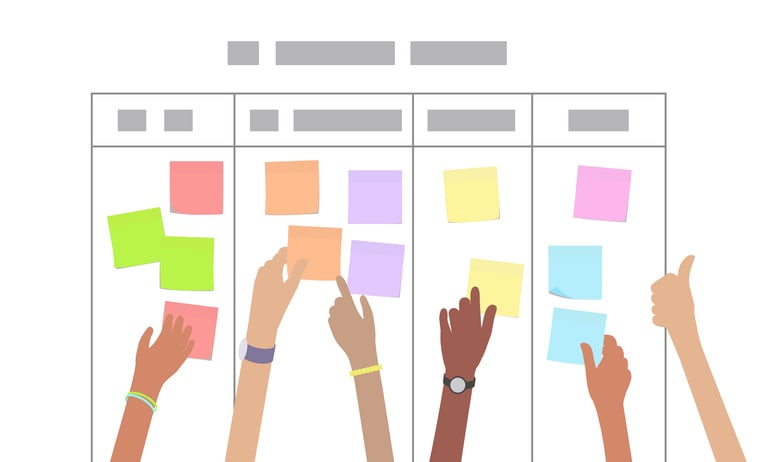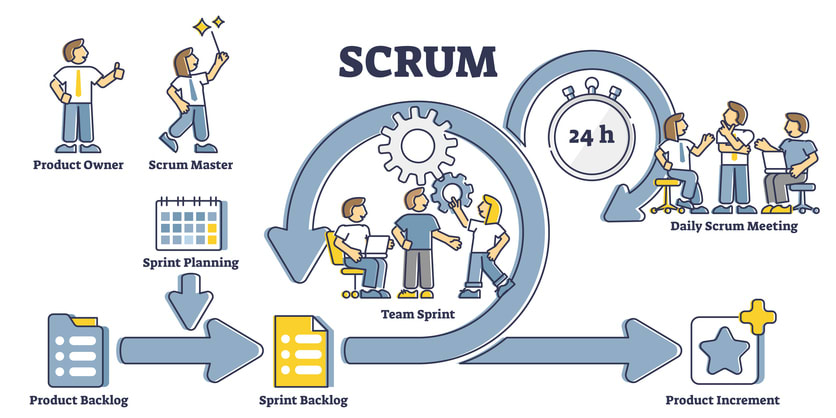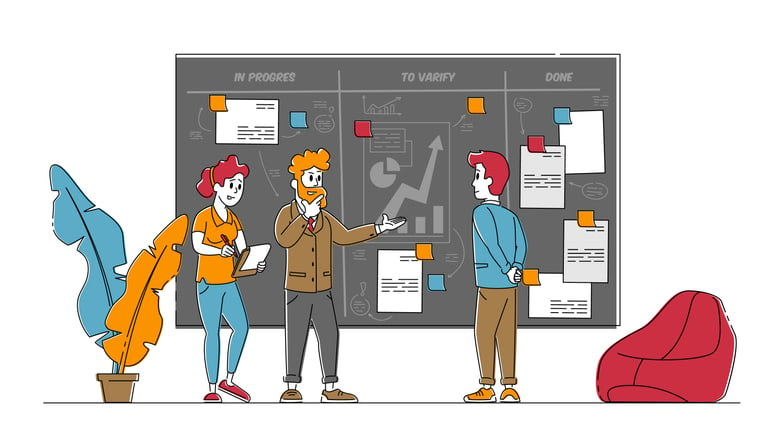Eager to discover ways to streamline your project management process, foster team collaboration, and enhance transparency? Look no further than Scrum, a popular Agile framework designed to create an environment of continuous improvement and feedback. The journey to understanding Scrum may seem like navigating through a dense forest, but with the right guide, the path becomes clear and inviting.
So let’s embark on a journey through this fascinating realm of Scrum. Together, we’ll traverse the origins of Scrum, its key principles, the roles that define a Scrum team, the artifacts and events that form the Scrum framework, and how you can implement Scrum in your own projects. We’ll also compare Scrum with other Agile frameworks and delve into real-world Scrum success stories. Ready? Let’s set foot on the path to Agile project success with Scrum.
Key takeaways
- Scrum is an Agile framework that promotes collaboration and continual improvement of software development projects.
- It consists of three distinct roles, artifacts, and events to facilitate decision-making & provide structure for successful completion.
- Real-world success stories demonstrate Scrum’s effectiveness in a variety of sectors and industries.
The essence of scrum

Scrum is more than just a buzzword in the project management field; it’s a revolutionary approach that has transformed the way teams work and deliver results. Originating as a rugby term, ‘Scrum’ embodies the idea of a team working together to move towards a common goal. In the context of project management, Scrum is an Agile framework designed to facilitate project management, particularly in the software development domain, through promoting collaboration, transparency, and continual enhancement.
Scrum, an Agile framework, emphasizes collective responsibility and teamwork throughout the scrum process. It outlines values, principles, and practices that Scrum teams follow to deliver a product or service. The Scrum team, which consists of the Product Owner, Scrum Master, and the Development Team, works together to ensure the successful completion of a project. The framework is composed of values, principles, and practices, as well as team members and their respective responsibilities, artifacts that define the product and the work that goes into creating it, and Scrum ceremonies that guide the team through their work.
The values underpinning Scrum encompass commitment, courage, focus, openness, and respect.
Origin and evolution of scrum
Scrum didn’t pop into existence overnight. Its roots can be traced back to a 1986 Harvard Business Review article by Hirotaka Takeuchi and Ikujiro Nonaka, where the term ‘Scrum’ was first used to describe a new approach to product development. The concept gradually evolved and was shaped by pioneers such as Jeff Sutherland, John Scumniotales, and Jeff McKenna, who implemented it in software development at Easel Corp in 1993. The Scrum methodology was further refined and formally presented in a paper titled “SCRUM Development Process” in 1995 by Ken Schwaber and Jeff Sutherland, along with others.
Over the years, Scrum has undergone several revisions to keep pace with the changing landscape of project management and software development. The latest iteration of the Scrum Guide was released in November 2020, reflecting the continued evolution of the framework. Today, Scrum stands as the most widely used Agile methodology, a testament to its adaptability and effectiveness in managing complex projects.
Key principles and values
Scrum isn’t simply a set of practices or a checklist to be followed; it’s built on a foundation of key principles and values that guide the team’s actions and decisions. These principles include:
- Adaptation: highlighting the necessity of being able to adapt and respond to modifications during the project, allowing the Scrum team to consistently enhance and modify their approach based on feedback and new information.
- Inspection: emphasizing the importance of regularly inspecting the progress and outcomes of the project to identify any issues or areas for improvement.
- Transparency: promoting open and transparent communication within the team and with stakeholders, ensuring that everyone has access to the same information and can make informed decisions.
These principles form the three pillars of Scrum and are essential for the successful implementation of the framework.
Adding to these principles are the five Scrum values:
- Commitment: embodying the dedication and accountability to achieve the team’s goals
- Courage: the willingness to challenge the status quo and overcome obstacles
- Focus: maintaining clear and unwavering attention on the team’s objectives
- Openness: fostering a culture of transparency and effective communication
- Respect: recognizing and valuing the contributions of each team member
These values are essential for a successful Scrum team.
These principles and values are not just theoretical aspects but are deeply ingrained in the daily operations of a Scrum team, serving as a compass that guides the team toward achieving their project goals.
Scrum framework components

Now that we’ve grasped the essence of Scrum, we can delve further into its key components. Consider these components as fundamental elements that collectively build the structure of a Scrum project. They provide a framework for decision-making, ensuring that every action and decision aligns with the principles and values of Scrum.
These components include roles, artifacts, and events. The roles are the Product Owner, Scrum Master, and the Development Team, each bringing unique skills and perspectives to the table. Artifacts in Scrum, such as the Product Backlog, Sprint Backlog, and the Increment, provide a tangible record of the team’s plans and progress.
Finally, the Scrum events, including:
provide regular checkpoints where the team can reflect, adapt, and plan their next steps.
Roles in scrum
In the Scrum framework, each role is unique, with its own set of responsibilities. The Product Owner, Scrum Master, and Development Team together form the Scrum Team, working in unison to deliver the project goals. Picture a well-coordinated orchestra, where each musician plays a distinct part but together, they create a harmonious symphony.
The roles in Scrum can be compared to an orchestra:
- The Product Owner, akin to a conductor, manages the product backlog, oversees risk tracking, and supervises the project governance.
- The Scrum Master, on the other hand, is like the first violinist, leading the team and ensuring the smooth running of Scrum ceremonies.
- Meanwhile, the Development Team, like the rest of the orchestra, collaborates to produce and evaluate incremental versions of the end product. Together, they form an ensemble, following the ‘two pizza rule’, which suggests that the team size should be limited to the amount that could be fed by two pizzas.
Scrum artifacts

In the Scrum ‘orchestra’, Scrum artifacts perform the role of ‘sheet music’. They provide a clear roadmap of what is to be done and track the progress made towards the project goals. These artifacts ensure transparency of key information, allowing for informed decision-making and alignment.
The Scrum framework consists of several artifacts, including:
- The Product Backlog: This is a comprehensive list of requirements necessary to fulfill customer expectations. It is prioritized by the Product Owner based on their relevance to the business.
- The Sprint Backlog: Derived from the Product Backlog, the Sprint Backlog outlines the work that the team has committed to do in the upcoming sprint.
- The Increment: This is a tangible output of the sprint, comprising all completed sprint backlog items.
Together, these artifacts provide a clear vision of the work to be done and the progress made, ensuring everyone is on the same page.
Scrum events
Scrum events parallel the rehearsals and performances in a Scrum ‘orchestra’. They provide regular checkpoints for the team to sync up, review progress, and plan their next steps. These events promote collaboration, enable progress tracking, and encourage continuous improvement.
Sprint Planning is a crucial step in determining the team’s objectives and plans. Here, the team defines which tasks can be tackled in the upcoming sprint, and how they will be accomplished. The daily scrum is a brief meeting where the team syncs up on their progress and plans for the day. The Sprint Review is where the team presents their work to stakeholders and gains feedback. Lastly, the Sprint Retrospective is a moment for the team to reflect on their work, identifying what went well and what can be improved. Together, these events ensure that the team is constantly learning, adapting, and moving forward in harmony.
Kumospace emerges as the ideal platform for Scrum due to its exceptional accessibility and streamlined communication features. Its virtual spaces foster a dynamic and collaborative environment, allowing team members to easily navigate and engage in spontaneous interactions, mirroring the fluid communication of physical Scrum rooms. With intuitive controls and interactive elements, Kumospace enhances accessibility, enabling seamless participation in daily stand-ups, sprint planning, and retrospective meetings. The platform's versatility accommodates visual representations of Scrum boards, facilitating effective task tracking and sprint progress visualization. Kumospace's commitment to streamlined communication makes it a valuable asset for Scrum teams, fostering a cohesive and efficient agile development process.
Implementing scrum in your projects

Now that we’ve examined the components of the Scrum framework, we can discuss its practical implementation in your projects. It’s like preparing for a concert. You need to assemble your orchestra, prepare your sheet music, and conduct regular rehearsals before you can put on a successful performance.
Forming a Scrum team necessitates the selection of individuals with varied skills who can work cohesively and adjust to the Scrum framework. Creating a prioritized product backlog is like preparing your sheet music. You identify and prioritize the tasks, features, and requirements based on customer needs and project goals.
Conducting regular Scrum ceremonies, like:
- sprint planning
- daily scrum
- sprint review
- sprint retrospective
is akin to conducting regular rehearsals, ensuring effective communication, progress tracking, and continuous improvement.
Assembling the scrum team
Just like assembling an orchestra requires a careful selection of musicians, assembling a Scrum team involves choosing individuals with the right mix of skills and capabilities who can work together effectively. The Scrum team consists of the Product Owner, Scrum Master, and the scrum development team, each with their unique responsibilities and functions.
The roles in Scrum are:
- The Product Owner: the visionary, translating customer needs into a prioritized product backlog
- The Scrum Master: the facilitator, ensuring the team has everything they need to perform at their best
- The Development Team: the doers, working together to deliver the increments.
Remember the ‘two pizza rule’ when assembling your team - you want a team that’s small enough to maintain efficient communication, but large enough to have a diverse range of skills.
Establishing the product backlog
Creating a product backlog involves:
- Identifying and prioritizing tasks, features, and requirements based on customer needs and project goals
- Maintaining a dynamic list that evolves with the project
- Reflecting new insights, changes in priorities, and customer feedback
The product backlog is like preparing the sheet music for your orchestra. It ensures that everyone is on the same page and working towards the same goals.
The Product Owner is primarily responsible for:
- Establishing and maintaining the product backlog
- Balancing the needs of the customer, the capacity of the team, and the strategic goals of the business
- Creating user stories
- Prioritizing backlog items
- Regularly refining the backlog to ensure it reflects the current understanding of the project.
Conducting scrum ceremonies

Conducting Scrum ceremonies is like conducting regular rehearsals with your orchestra. It provides regular opportunities for the team to sync up, review progress, and plan their next steps. These ceremonies promote collaboration, enable progress tracking, and encourage continuous improvement.
There are four key ceremonies in the Scrum framework:
- Sprint Planning: where the team decides what they will work on in the upcoming sprint.
- Daily Scrum: a quick sync-up to discuss what was done the previous day, what will be done today, and any obstacles that need to be addressed.
- Sprint Review: a chance to present the increment to stakeholders and gain their feedback.
- Sprint Retrospective: a moment for the team to reflect on their work and identify areas for improvement.
By conducting these ceremonies regularly, the team can ensure they are always learning, adapting, and moving forward.
Scrum vs. other agile frameworks

Though Scrum is a popular choice, it’s not the only Agile framework out there. Just like there are different genres of music, there are different Agile frameworks, each with its own unique approach to project management and software development.
This section will juxtapose Scrum with other Agile frameworks, emphasizing their primary differences and similarities. Specifically, we’ll take a closer look at Kanban, another popular Agile framework, and discuss how to choose the right framework for your project. Just as a musician might choose a different genre depending on the audience, the nature of your project and the specific needs of your team will influence which Agile framework is the best fit.
Scrum and Kanban
Though both Scrum and Kanban are commonly used Agile frameworks, their focuses differ. Scrum is like classical music, with its fixed-length iterations (sprints) and structured approach. On the other hand, Kanban is more like jazz, with its emphasis on a continuous flow of tasks and its flexibility to make changes on the fly.
Scrum’s structure includes roles, artifacts, and ceremonies, and it requires the team to commit to a set of outcomes for each sprint. Kanban, however, focuses on visualizing tasks and does not require a commitment for a set period. It also doesn’t have defined roles, so it can be more flexible in terms of team structure.
Each possesses its own strengths, and your project’s nature and your team’s needs will influence your choice between them.
Choosing the right framework
Choosing the right Agile framework for your project is like choosing the right instrument for a piece of music. It depends on factors such as the nature of the project, the size of your team, and the specific goals of your organization.
Scrum is more structured, making it a good choice for teams that need a clear framework to guide their work. It’s also a good fit for projects that require close collaboration and frequent feedback. On the other hand, Kanban offers more flexibility, making it suitable for projects where changes are frequent and teams need to be able to adapt quickly.
Ultimately, the choice of framework should align with your team’s capabilities and your project’s needs.
Overcoming challenges in scaling Scrum

The process of scaling Scrum for larger projects or multiple teams is akin to conducting a symphony orchestra, necessitating meticulous coordination and clear communication for harmonious teamwork. But just like an experienced conductor can guide a large orchestra to a successful performance, there are techniques and frameworks that can help you overcome the challenges of scaling Scrum.
This section will address common challenges encountered while scaling Scrum, including coordinating multiple teams, maintaining effective communication, and ensuring consistency in processes and objectives. We’ll also explore scaling frameworks and techniques that can provide guidance and principles for effectively scaling Scrum to larger projects and organizations.
Common scaling issues
Scaling Scrum can be like trying to choreograph a dance routine for a large group - it’s not just about replicating the same steps, but coordinating everyone’s movements so they’re all in sync. When you scale Scrum to multiple teams, you may face challenges such as:
- Coordinating across teams
- Managing dependencies
- Ensuring shared ownership and alignment of goals
- Addressing the complexities of a single-product/multiple-team setup
Communication can also become more challenging as the number of team members increases. It’s like trying to have a conversation in a crowded room - the more people there are, the harder it is to make sure everyone is heard and understood. Likewise, maintaining consistency in processes and goals across multiple teams can be like trying to keep all the musicians in an orchestra playing in time - it requires clear communication and strong leadership.
Scaling frameworks and techniques
Similar to techniques for conducting a large orchestra or choreographing a large dance group, there exist frameworks and methodologies for scaling Scrum. These guide how to coordinate multiple teams, manage dependencies, and ensure that everyone is working towards the same goals.
Scaled Agile Framework (SAFe), Scrum of Scrums, and Large-Scale Scrum (LeSS) are some of the frameworks that have been established for scaling Scrum. These frameworks provide principles and practices for managing large-scale projects, helping to ensure that the benefits of Scrum - such as improved collaboration, increased productivity, and continuous improvement - are realized even as the size of the team or the scope of the project grows.
Real-world scrum success stories

Scrum, like any framework or methodology, is not just about theory - it’s about how it’s applied in practice. And there’s no better way to understand the impact of Scrum than by looking at real-world success stories. These stories provide tangible evidence of how Scrum can help teams deliver high-quality products, foster collaboration and innovation, and drive continuous improvement.
Various companies ranging from:
- Yahoo
- Microsoft
- Adobe
- Nokia
- Siemens
- BBC
- CNN
- General Electric
- Bank of America
- Sony
- LEGO
- CISCO
- Mitsubishi
have utilized Scrum for the successful delivery of projects from website development to mobile application development. Not limited to software development, industries like marketing, construction, event planning, product development, finance, and even production and maintenance areas of businesses have also tapped into the benefits of Scrum. This widespread application of Scrum across different sectors and industries demonstrates its adaptability and relevance in today’s fast-paced project environment.
Summary
We’ve journeyed through the world of Scrum, from its origins and principles to its real-world applications. We’ve explored the roles, artifacts, and events that make up the Scrum framework, and how they come together to deliver high-quality products. We’ve seen how Scrum promotes collaboration, transparency, and continuous improvement, and how it can be scaled to larger projects and multiple teams.
So, whether you’re managing a small project or coordinating a large team, Scrum offers a flexible and effective approach to project management. With its emphasis on collaboration, transparency, and continuous improvement, Scrum can help you navigate the complexities of project management and deliver high-quality products that meet your customers’ needs. So why wait? Embrace the power of Scrum and guide your team to project success.
Frequently Asked Questions
Scrum is a management framework that teams use to self-organize and work towards a common goal, by describing meetings, tools, and roles for efficient project delivery. It involves short cycles called sprints, led by a Scrum master whose job is to remove obstacles, with teams meeting daily to discuss tasks and any roadblocks.
Agile is a set of values and principles that emphasize flexibility, while Scrum is a structured approach within the Agile framework. It enables rapid delivery of products for feedback, enabling continuous iteration in development and testing.
Scrum is not an acronym; it is the shortened form of a rugby term "scrummage" and refers to the formation the team takes when attempting to move the ball down the field. It is used in Agile software development to signify the coming together of people to work on a task collaboratively.
To implement Scrum in your projects, assemble a cross-functional team, create a product backlog, and hold regular Scrum ceremonies.
While Kumospace has a variety of features that can be utilized for Scrum, the most effective uses include: creating a virtual Scrum room, streamlined team collaboration, using the whiteboard feature for Scrum visualization boards, and document sharing and integration.
Scrum has enabled successful projects for companies like Google, Yahoo, Microsoft, and Facebook, as well as a variety of industries such as marketing, construction, event planning, product development, finance, and production and maintenance.





